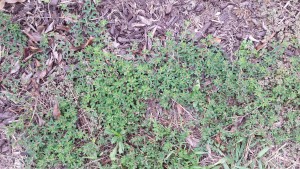Spotted spurge (Euphorbia maculata) is a dreadful perennial weed that can quickly take over a lawn or garden bed. It often grows in poor compacted soils or in-between cracks in pavement. Once established, it is difficult to eliminate it from your garden.
Ideal temperature range for seed germination is 75 to 85 °F, and spurge will germinate in soil temperatures between 60 and 100 °F. Spotted spurge is most active from February through September.
Spotted spurge grows low to the ground like a carpet. Tiny leaves are dark green with reddish stems. Oval-shaped leaves (1/8 – 1/2 inch long) have a dark spot in the center. Plant is covered with fine hairs and its small pink flowers often go unnoticed. Its tap root grows long and deep. Seeds are prolific and are very hardy. Spotted spurge can grow back from either root pieces or seeds. It is a prolific seeder or can spread rapidly.
Hand-pulling in flower beds and vegetable gardens is no easy chore, and you must stay on top of it. The plant fans out from a main root, so yanking it rarely gets all the deep roots. Wear gloves as the milky sap can irritate your skin. Repeatedly weeding a bed eventually weakens the plant and eliminates it.
Glyphosate (Round-up® and similar trade name products) are very effective against spotted spurge. These herbicides are translocated, and eradicate all vegetation after multiple applications. It may re-grow from its deep taproot or from seeds dispersed from a neighbor’s yard. Stay vigilant and re-apply as needed. Contact weed killers become less effective as the plant’s foliage matures later in the year.
Barricade® (prodiamine) is a pre-emergent herbicide that stops weed seeds from germinating in your garden. It will not kill weed seedlings that have already sprouted.
Heavy mulching with several layers of newspaper or wood mulch is also an effective method of controlling spotted spurge.
In areas where spotted spurge is rampant, solarization may be your last resort. Blanket the weedy patch with plastic to kill off all vegetation. Allow 6-8 weeks to kill this tough weedy pest. Remove the plastic and seed lawn grass or garden bed in late summer or next spring.


 Posted in
Posted in 
